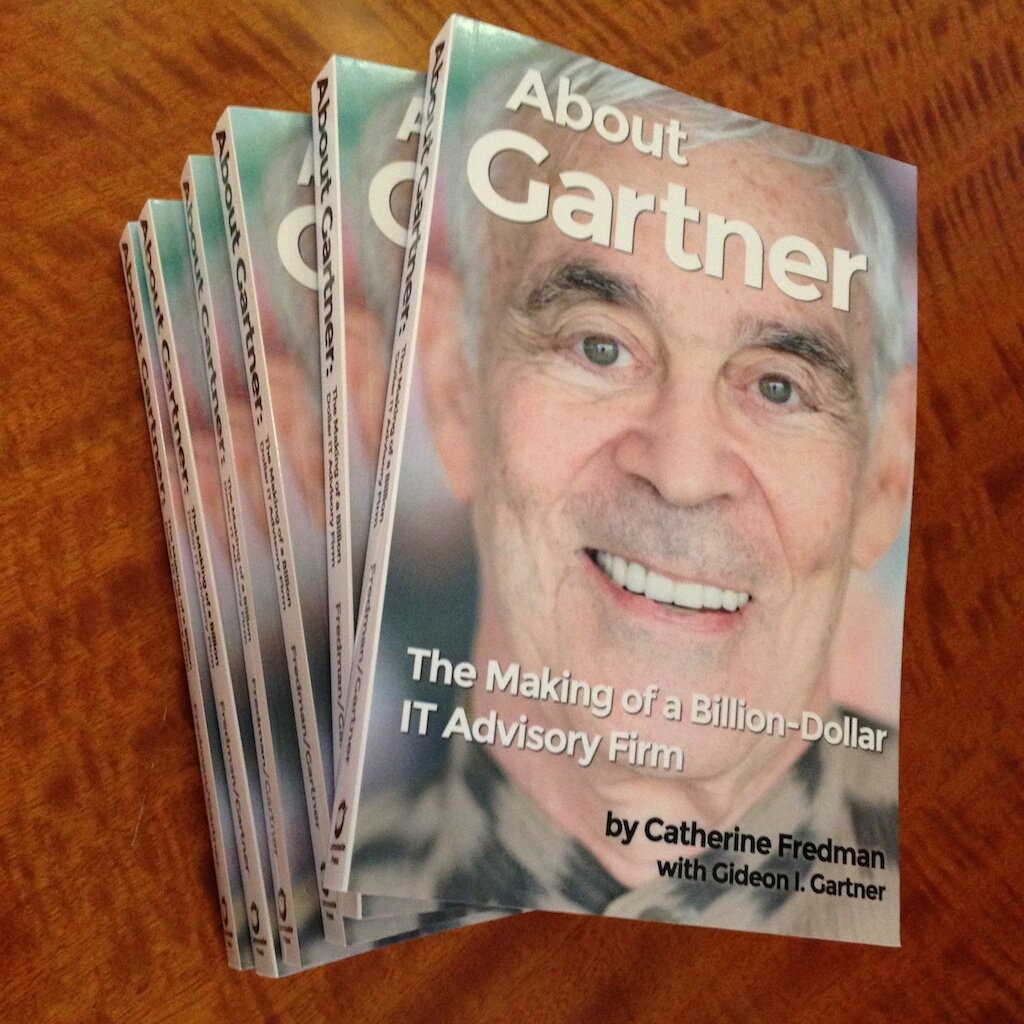Posted on Oct 9, 2014 in Advisory, Gartner, Inc., Gideon Gartner, The Founding of Gartner | 35 comments

Gartner Inc. (originally called Gartner Group) was born on April 1, 1979, together with a chap named David Stein. I had just predicted that the estimated $200 million ‘Information Industry’ (information about the realm of computers) would continue growing at an annual rate of 30%, and that we should attempt applying our knowledge, in order to share the expected growth. At the time I...
read more
Posted on Aug 12, 2011 in IBM vs. Gartner, 1980s | 34 comments

IBM vs. Gartner During the 1980s, Part 4 As we moved forward, our responsibility was to continue analyzing the IT industry objectively for all our clients, and not about IBM in particular or for its benefit. Throughout the decade our company’s mission continued the education of all players in the IT marketplace, including those vendors who were meaningful, the large users and investors,...
read more
Posted on Aug 10, 2011 in IBM vs. Gartner, 1980s | 14 comments

IBM vs. Gartner During the 1980s, Part 3 Here’s how the drama continued to unfold: In early March 1993 I was shocked to receive a call followed by a personal visit in my office by two people associated with IBM: Tom Barr and Nicholas Katzenback. Tom Barr was Cravath Swaine & Moore’s most famous lawyer and was handling the entire IBM account. Nicholas Katzenbach is a Rhodes...
read more
Posted on Aug 8, 2011 in IBM vs. Gartner, 1980s | 35 comments

IBM vs. Gartner During the 1980s, Part 2 Several months passed after having spoken to IBM’s Don Otis I received another critical phone call, this time an indirect call from Ron Rolfe of Cravath Swaine and Moore, IBM’s counsel and the acknowledged heavy hitter of the entire U.S.’s legal profession! So once again the lawyers were getting into the act, always persistent, always...
read more
Posted on Aug 6, 2011 in IBM vs. Gartner, 1980s | 11 comments

IBM vs. Gartner During the 1980s, Part 1 After leaving Oppenheimer to create, launch and manage Gartner Group in 1979, I continued to personally write and publish about the IBM Corporation — just as I had done previously for my financial buy-side clients (banks, insurance companies, et al.). Forbes quoted me in 1972: “there is nothing IBM does that fails to impact every aspect...
read more
Posted on Jul 4, 2011 in Advisory | 26 comments
I’m copying a public post by Phil Fersht, adding a few minor edits and comments below. Phil asked the question: “Are the days of the traditional industry analyst firms numbered?” and offered his doubts to the public (in some detail). Perhaps his conclusions were overstated, but perhaps not; some version of today’s Advisories will undoubtedly survive. But the comments seem to...
read more
Posted on Apr 19, 2011 in Gartnerite Memories | 3 comments
Stan Dale had just joined Gartner Group in sales, the summer of 1983. His territory was New England and shortly thereafter Bell Canada was added to his accounts. The following spring he and his associates decided to do some prospecting seminars in Canada – Bell Canada was then Gartner’s only Canadian account and they were receiving only one service, Telecom (STS). It was...
read more
Posted on Apr 18, 2011 in Gartnerite Memories | 6 comments
Peggy Pedwano was one of our most reliable and enthusiastic administrators, which is saying much given the strength of our admin, which was crucial in delivering client service. Her fondest memories of Gartner are the earliest days of everyone working together whether typing up greensheets (on IBM Selectric typewriters!), to stuffing binders, to prepare and enjoy “Gartner Gatherings”, and...
read more
Posted on Apr 14, 2011 in Gartner, Inc. | 8 comments

Part 1: AFTER HUTTON & OPPENHEIMER, VCs INTERVENE In early 1970 E.F. Hutton hired me as a technology analyst, despite my having little financial background. One of my early successes was a detailed and timely report on Xerox Corp., then a ‘nifty fifty’ firm with steady growth and broad popularity among institutional investors. The report raised concerns that Xerox’s growth might...
read more
Gartner: Early “Theory G” & Sales, Part 4
Posted on Mar 6, 2011 in Gartner, Inc. | 12 comments

Around 1986 I was still working to formalize and document how Gartner’s culture had evolved since its 1979 founding; seven years old, it continued to maintain (and fine tune) its original research methods, but now embraced sales goals as well. By the following year 1987, we published our methods internally, distributed to our employees as “Theory G”. In hindsight, the name...
read more
Sharpening Instincts: Review of an IT post
Posted on Mar 1, 2011 in Non-Gartner Advisory | 11 comments

Tony Greenberg wrote a recent blog post (on tonygreenberg.com) which pertains to IT trends; when reading it I wondered if it had any implications for the Advisory industry…. Readers should note that Tony is an ‘outsourcing’ advocate; I’ll summarize his article with my comments in brackets, and then ask a question: We need to sharpen our instincts and stop trusting IT...
read more
Gartner: Early Research Process, Part 3 (80/20 Rule)
Posted on Feb 8, 2011 in Gartner, Inc. | 7 comments

Gartner’s Research Meetings When VCs Neill Brownstein and Chris Brody convinced me to leave Oppenheimer to found Gartner, they demanded a document that would guarantee their receipt of Gartner research, indefinitely! This led me to realize the importance of terse written research, and we structured our research meetings to enhance our research process, which would then...
read more
Posted on Feb 6, 2011 in Gartner, Inc. | 12 comments

In Part 1 of this post I mentioned some of the sources for my research process ideology, resulting in a 1980s ‘research process’ for Gartner which included six major elements: Surveillance, Pattern Recognition, Stalking Horses (including the Magic Quadrant), Search, Document, and Strategic Planning Assumptions (primarily for conferences); while perhaps not followed explicitly,...
read more
Posted on Jan 31, 2011 in Gartner, Inc. | 10 comments

Gartner’s Original Research process Part 1. I was influenced during Gartner Group’s first year (March 1979-April 1980) by reading two public documents: the book “the Tao Jones Averages: A Guide to Whole-Brained Investing” by Bennet Goodspeed, and an article written by David B. Montgomery and Charles B. Weinberg ‘Toward Strategic Intelligence Systems’...
read more
Posted on Jan 26, 2011 in Non-Gartner Advisory | 5 comments

The New York Times on 1/25/2011 printed a photograph of a gentleman looking down at a chessboard, with an interesting subtitle: Pattern recognition is what sets experts apart from novices. The article points out that “when subjects were shown a chess diagram, the novices looked directly at the pieces to recognize them, while the experts looked on the middle of the boards and took...
read more
IBM vs. Gartner During the 1980s
Posted on Dec 25, 2010 in Gartner, Inc. | 1 comment

Part 1. After leaving Oppenheimer to create, launch and manage Gartner Group in 1979, I continued to personally write and publish about the IBM Corporation just as I had done previously for my financial buy-side clients (banks, insurance cos., et al). Forbes quoted me in 1972: “there is nothing IBM does that fails to impact every aspect of the industry…I prefer to know the...
read more
Advisory Client Satisfaction Issues
Posted on Oct 21, 2010 in Non-Gartner Advisory | 7 comments

A recent question posed to fifteen CIOs (or equivalent) regarding value received from Advisory deliverables, resulted in the answers below (Gartner was not mentioned by me, but virtually all of these were Gartner clients) The question: How do you measure the value you obtain from your current IT advisory service subscriptions? The answers: We don’t measure it. Not sure we’re getting...
read more
Posted on Aug 17, 2010 in Non-Gartner Advisory | 6 comments

Will advisory services recover from current sluggish levels? Whether sold commercially, or distributed internally, knowledge produced by for-profit companies (as compared to information available for free on the web) will continue to be under strong pressures to be priced, because knowledge costs money to produce. In fact, we are now witnessing a rationalization of pricing levels in the...
read more
Posted on Aug 5, 2010 in Non-Gartner Advisory | 6 comments

Mike Simmons of IDG, editor of ComputerWorld UK, recently referred to my post, called: a Gartner publication, with G.Gartner’s comments. (find it at http://blogs.computerworlduk.com/editors-blog/2010/07/gideon-gartner-takes-a-swipe-at-the-analyst-group-he-founded/index.htm) You’ll find this (currently) on the front page of my blog (otherwise, search on “The Advisory...
read more
Posted on Jul 29, 2010 in Non-Gartner Advisory | 21 comments

By Barbara French and Gideon Gartner (@bfr3nch, www.barbarafrench.net, @gideongartner,gideongartner.com) In the first part of this post, we challenged an urban myth that small analyst firms are threatening the Gartner and Forrester Research business models. We as yet see no compelling evidence. What we do see is many small advisory firms performing vital roles in the IT ecosystem, a few...
read more
Posted on Jul 23, 2010 in Non-Gartner Advisory | 50 comments

G.Gartner’s note: the purpose of this post is to describe Gartner Inc.’s own chronology of its early years, with my comments in brackets [ ], which represent an attempt to help set the record straight. This post is not meant to describe the innovations which resulted in Gartner’s growing from zero to dominating its field within a decade, the 1980s. I’ll switch my...
read more
Posted on Jun 29, 2010 in Non-Gartner Advisory | 50 comments

By Barbara French and Gideon Gartner (@bfr3nch, www.barbarafrench.net, @gideongartner,gideongartner.com) There’s a good deal of speculation on whether the research and advisory business is entering a new phase — one in which small Advisory firms may be thriving at the expense of the large firms. David Hatch summed up this point of view in a forestercomment to “Advisory Industry, a...
read more
Posted on Jun 18, 2010 in Gartner, Inc. | 48 comments

Soundview Part 2: The later years Banking relationships at most of the other Wall Street tech boutiques like Montgomery Securities were more important than research, which was often seen as creating a conflict. But Soundview’s concentration on research and research culture was as strong as it had been at Gartner Group even though it paid less than Wall Street’s elevated salaries and...
read more
A Deal with The Devil: Gartner Refuses to be Sold Down the River Part II
Posted on May 27, 2010 in Non-Gartner Advisory | 3 comments
This is part two of a 2-part series. Click here to read Part I. When it was their turn to present, the CEO went through a somewhat plastic presentation, a standard sounding pitch which was undoubtedly used to charge up the people in his numerous offices around the world, and possibly to impress clients as well. There was little value-add, and when he got to the benefits to Gartner which a...
read more
Posted on May 26, 2010 in Non-Gartner Advisory | 3 comments
This is a story presented in two parts… The material below describes the visit of the CEO and officers of a very large company (all of whom will be nameless), when the firm was bidding to acquire our company from Saatchi, despite our resistance. Gartner and 10 other consultancies were put on the auction block by Saatchi & Saatchi in June 1989, and in late October one of the firms...
read more

























